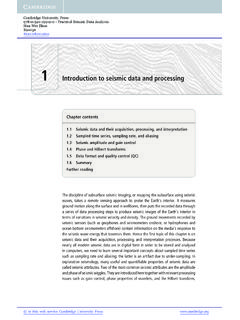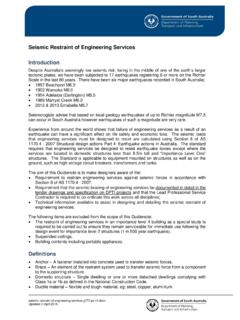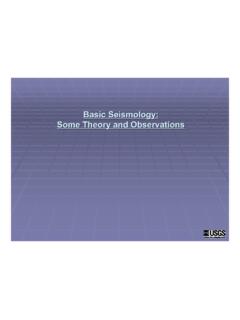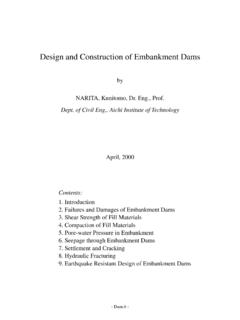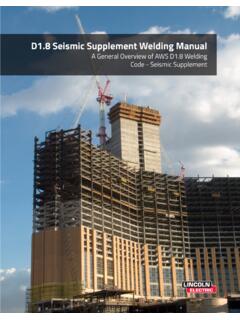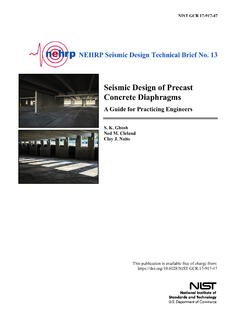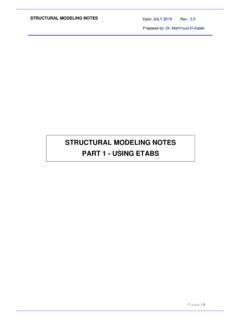Transcription of SEG Y rev 1Release 1
1 SEG Y rev 1 data Exchange format1 SEG Technical Standards Committee2 Release , May 2002 1 2001, Society of Exploration Geophysicist. All rights reserved. 2 Editors Michael W. Norris and Alan K. Faichney SEG Y rev 1 May 2002 iiContent 1. 1 2. 1 UNCHANGED 1 CHANGES FROM REV 0 TO REV 1 .. 1 1 CONTROLLING 1 1 3. SEG Y FILE STRUCTURE .. 2 RECORDING 2 FILE 3 NUMBER 3 VARYING TRACE 3 4 4. TEXTUAL FILE HEADER .. 4 5. BINARY FILE HEADER .. 6 6. EXTENDED TEXTUAL FILE 9 STRUCTURE OF EXTENDED TEXTUAL 10 ENDTEXT 11 STANZA 11 7. data TRACES ..12 TRACE 12 TRACE 20 APPENDIX A. WRITING SEG Y data TO A DISK FILE .. 20 APPENDIX B. SEG Y TAPE LABELS .. 21 APPENDIX C. BLOCKING OF SEG Y FILES ON 23 APPENDIX D. EXTENDED TEXTUAL STANZAS .. 24 D-1. LOCATION 24 Stanza for Location data .. 24 Example Stanza for Location data .. 26 D-2. BIN GRID 27 Stanza for Bin Grid 27 Example for Bin Grid Definition.
2 30 D-3. data GEOGRAPHIC EXTENT & COVERAGE 31 Stanza for data Geographic Extent .. 33 Example for data Geographic Extent .. 33 Stanza for Coverage Perimeter .. 34 Example Stanza for Coverage Perimeter .. 35 This example is based on Figure 3.. 35 D-4. data SAMPLE MEASUREMENT 36 Stanza for data Sample Measurement Unit .. 36 Example stanza for data Sample Measurement Unit .. 36 D-5. PROCESSING 37 Stanza for Processing 37 SEG Y rev 1 May 2002 Example stanza for Processing History .. 37 D-6. SOURCE 38 Stanza for Source 38 Example stanza for Source Type/Orientation .. 38 D-7. SOURCE MEASUREMENT 39 Stanza for Source Measurement 39 Example stanza for Source Measurement Unit .. 39 APPENDIX E. data WORD FORMAT .. 39 APPENDIX F. EBCDIC AND ASCII CODES .. 42 APPENDIX G. 45 FIGURES FIGURE 1 BYTE STREAM STRUCTURE OF A SEGY FILE WITH N EXTENDED TEXTUAL FILE HEADER RECORDS AND M TRACES 2 FIGURE 2 BIN GRID 28 FIGURE 3 VARIOUS data EXTENTS AND COVERAGE PERIMETERS FOR A seismic 32 TABLES TABLE 1 TEXTUAL FILE 5 TABLE 2 BINARY FILE 6 TABLE 3 TRACE 12 TABLE 4 SEG Y TAPE 21 TABLE 5 STANZA FOR LOCATION 24 TABLE 6 STANZA FOR BIN GRID 28 TABLE 7 STANZA FOR data GEOGRAPHIC 33 TABLE 8 STANZA FOR COVERAGE 34 TABLE 9 STANZA FOR data SAMPLE MEASUREMENT 36 TABLE 10 STANZA FOR PROCESSING 37 TABLE 11 STANZA FOR SOURCE 38 TABLE 12 STANZA FOR SOURCE MEASUREMENT 39 TABLE 13 IBM 3270 CHAR SET REF CH 10, GA27-2837-9, APRIL 42 SEG Y rev 1 May 2002 11.
3 introduction Since the original SEG Y data Exchange Format (revision 0, reference page 45) was published in 1975 it has achieved widespread usage within the geophysical industry. This widespread usage has brought about many proprietary variations. Since the publication of SEG Y rev 0, the nature of seismic data acquisition, processing and seismic hardware has changed significantly. The introduction of 3-D acquisition techniques and high speed, high capacity recording media dictate the need for revisions to the SEG Y rev 0 format. The major changes introduced by SEG Y rev 1 are: standardizing the location of header information needed for current processing practices and defining a SEG Y data set as a byte stream format. The SEG Technical Standards Committee strongly encourages producers and users of SEG Y data sets to move to the revised standard in an expeditious fashion. 2. Summary Unchanged Items EBCDIC encoding is allowed for text.
4 The size of the original 3200-byte Textual File Header, 400-byte Binary File Header and 240-byte Trace Headers. The data locations for the initial 3200-byte Textual File Header Changes from rev 0 to rev 1 A SEG Y file may be written to any medium that is resolvable to a stream of variable length records. The data word formats are expanded to include four-byte, IEEE floating-point and one-byte integer data words. A small number of additional fields in the 400-byte Binary File Header and the 240-byte Trace Header are defined and the use of some existing entries is clarified. An Extended Textual File Header consisting of additional 3200-byte Textual File Headers blocks is introduced. The data in the Extended Textual File Header uses a stanza layout and standard stanzas are defined. Trace identification is expanded. Engineering conversions are introduced. The Textual File Header and the Extended Textual File Header can be encoded as EBCDIC or ASCII characters.
5 Notation The term CDP as used in this document is used as a synonym for the term CMP. Controlling Organization The SEG Y rev1 is administered by the SEG Technical Standards Committee. Any questions, corrections or problems encountered in the format should be addressed to: Society of Exploration Geophysicist Box 702740 Tulsa, Ok 74170-2740 Attention: SEG Technical Standards Committee Phone: (918) 497-5500 Fax: (918) 497-5557 Internet site: Acknowledgments The SEG Technical Standards Committee would like to acknowledge the time and effort put forth by a great many individuals and organizations. Special commendation goes to the data Management Group. The chairman of data Management Group was Jill Lewis. The SEG Y rev 1 May 2002 2principal members were Bob Firth, Eleanor Jack and Jill Holliday. Roger Lott produced the Extended Textual stanzas for Location data , Bin Grid Definition and data Extent. Thanks go to Frank Brassil for organizing the response from the Australian Geological Society.
6 3. SEG Y File Structure The original SEG Y standard was produced at a time when 9-track tape was the normal storage medium for seismic data , with 800 bpi and 1600 bpi in common usage and 6250 bpi on the horizon. The revised format is intended to be independent of the actual medium on which it is recorded. The stipulation in the 1975 standard that no more than one line of seismic data is permitted on any one reel became impractical long ago. The term SEG Y file shall be used in this revision in place of the term seismic reel used in the original standard. For this standard, the terms file and data set are synonymous. Both terms are a collection of logically related data traces or ensembles of traces and the associated ancillary data . Recording Medium The SEG Y format described in the 1975 standard defined a data format that was dependent on 9-track tape. With the revised format, a SEG Y file may be written to any medium that supports variable length records.
7 Whatever medium is used, the data must be resolvable to a stream of variable length records. This includes tape devices, such as 9-track tape and 3480 cartridges, which can achieve this in hardware. It also includes high capacity tape devices such as DD2 or 3590, although with these it is desirable to use some kind of blocking and/or logical encapsulation, to use the tape more efficiently and possibly to allow the recording of associated metadata. A SEG Y file may be written as a logical file to a SEG RODE encapsulated tape. Obviously when seismic data is being exchanged in SEG Y format, the medium and encapsulation scheme used must be acceptable to both the provider and recipient of the data . One important class of media that does not conform to the variable length record model is the disk file, which is defined on modern systems as a byte stream without any structure. It has become common practice to write SEG Y data to disk, including CD-ROM, for data distribution.
8 Certain rules have to be followed for this to work correctly. Appendix A defines how SEG Y data should be written to a disk file. In order to make SEG Y consistent with the SEG D Rev 2 standard, Appendix B defines a tape label for SEG Y tapes, using a format based on the RP66 Storage Unit Label. Labels are not mandatory for SEG Y; but their use is highly desirable in environments such as robotic tape libraries and large scale processing centers. Appendix C defines a simple blocking scheme for SEG Y data to allow more efficient use of high-capacity tape media. byteTextualFileHeader400 byteBinaryFileHeader1st(Optional)3200 byteExtendedTextual,FileHeaderNth3200 byteExtendedTextualFileHeader1st240 byteTraceHeaderMth240 byteTraceHeader1stDataMthDataTraceOption alSEG YTapeLabelTrace(Optional)3200 Figure 1 Byte stream structure of a SEGY file with N Extended Textual File Header records and M traces records SEG Y rev 1 May 2002 3 This is based on the scheme defined in the SEG D Rev 2 standard.
9 File Structure Figure 1 illustrates the structure of a SEG Y file. The first 3600-bytes of the file are the Textual File Header and the Binary File Header written as a concatenation of a 3200-byte record and a 400-byte record. This is optionally followed by Extended Textual File Header(s), which consists of zero or more 3200-byte Extended Textual File Header records. The remainder of the SEG Y file contains a variable number of data Trace records that are each proceeded by a 240-byte Trace Header. The Extended Textual File Header is the only structural change introduced in this revision and while not strictly downward compatible with the 1975 SEG Y format, it has been carefully designed to have minimal impact on existing SEG Y reader software. It should be simple for existing software to be modified to detect the presence of the new header and either process or ignore the Extended Textual File Header. The format of the Extended Textual File Header is described fully in section 6.
10 Number Formats In the 1975 SEG Y standard, all binary values are defined as using big-endian byte ordering. This conformed to the IBM tape standard and means that, within the bytes that make up a number, the most significant byte (containing the sign bit) is written closest to the beginning of the file and the least significant byte is written closest to the end of the file. This byte ordering convention is maintained in this revision of the SEG Y format and it should be adhered to for all conforming versions of SEG Y. This is independent of the medium to which a particular SEG Y file is written ( the byte ordering is no different if the file is written to tape on a mainframe or to disk on a PC). All values in the Binary File Header and the Trace Header are two's complement integers, either two bytes or four bytes long. There are no floating-point values defined in the headers. Trace data sample values are either two's complement integers or floating-point.
